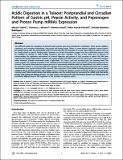Por favor, use este identificador para citar o enlazar a este item:
http://hdl.handle.net/10261/47514COMPARTIR / EXPORTAR:
 SHARE SHARE
 CORE
BASE CORE
BASE
|
|
| Visualizar otros formatos: MARC | Dublin Core | RDF | ORE | MODS | METS | DIDL | DATACITE | |

| Título: | Acidic Digestion in a Teleost: Postprandial and Circadian Pattern of Gastric pH, Pepsin Activity, and Pepsinogen and Proton Pump mRNAs Expression |
Autor: | Yúfera, Manuel CSIC ORCID ; Moyano, Francisco Javier; Astola, A. CSIC ORCID; Pousão-Ferreira, P.; Martínez-Rodríguez, Gonzalo CSIC ORCID | Fecha de publicación: | 20-mar-2012 | Editor: | Public Library of Science | Citación: | PLoS ONE 7(3): e33687 (2012) | Resumen: | Two different modes for regulation of stomach acid secretion have been described in vertebrates. Some species exhibit a continuous acid secretion maintaining a low gastric pH during fasting. Others, as some teleosts, maintain a neutral gastric pH during fasting while the hydrochloric acid is released only after the ingestion of a meal. Those different patterns seem to be closely related to specific feeding habits. However, our recent observations suggest that this acidification pattern could be modified by changes in daily feeding frequency and time schedule. The aim of this study was to advance in understanding the regulation mechanisms of stomach digestion and pattern of acid secretion in teleost fish. We have examined the postprandial pattern of gastric pH, pepsin activity, and mRNA expression for pepsinogen and proton pump in white seabream juveniles maintained under a light/dark 12/12 hours cycle and receiving only one morning meal. The pepsin activity was analyzed according to the standard protocol buffering at pH 2 and using the actual pH measured in the stomach. The results show how the enzyme precursor is permanently available while the hydrochloric acid, which activates the zymogen fraction, is secreted just after the ingestion of food. Results also reveal that analytical protocol at pH 2 notably overestimates true pepsin activity in fish stomach. The expression of the mRNA encoding pepsinogen and proton pump exhibited almost parallel patterns, with notable increases during the darkness period and sharp decreases just before the morning meal. These results indicate that white seabream uses the resting hours for recovering the mRNA stock that will be quickly used during the feeding process. Our data clearly shows that both daily illumination pattern and feeding time are involved at different level in the regulation of the secretion of digestive juices. | Versión del editor: | http://dx.doi.org/10.1371/journal.pone.0033687 | URI: | http://hdl.handle.net/10261/47514 | DOI: | 10.1371/journal.pone.0033687 | ISSN: | 1932-6203 |
| Aparece en las colecciones: | (ICMAN) Artículos |
Ficheros en este ítem:
| Fichero | Descripción | Tamaño | Formato | |
|---|---|---|---|---|
| journal.pone.0033687.pdf | 749,53 kB | Adobe PDF |  Visualizar/Abrir |
CORE Recommender
PubMed Central
Citations
9
checked on 30-mar-2024
SCOPUSTM
Citations
77
checked on 23-abr-2024
WEB OF SCIENCETM
Citations
67
checked on 26-feb-2024
Page view(s)
437
checked on 24-abr-2024
Download(s)
232
checked on 24-abr-2024
Google ScholarTM
Check
Altmetric
Altmetric
Artículos relacionados:
NOTA: Los ítems de Digital.CSIC están protegidos por copyright, con todos los derechos reservados, a menos que se indique lo contrario.
